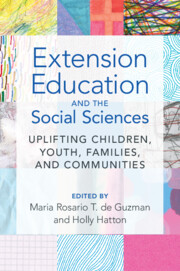Book contents
- Extension Education and the Social Sciences
- Extension Education and the Social Sciences
- Copyright page
- Contents
- Contributors
- Part I Overview of Extension and the Social Sciences
- Chapter 1 Introduction
- Chapter 2 Engaged Scholarship
- Chapter 3 Extension’s Role in Promoting Resilience among Rural Families with Low Incomes
- Chapter 4 Extension Programming to Enhance Urban Well-Being
- Part II Addressing Key Issues in the Well-Being of Children, Youth, and Families
- Part III Looking Ahead: Emerging Issues and Trends
- Index
- References
Chapter 2 - Engaged Scholarship
Navigating the Role of Research in Extension Using a Relationship Education Case Example
from Part I - Overview of Extension and the Social Sciences
Published online by Cambridge University Press: 28 March 2024
- Extension Education and the Social Sciences
- Extension Education and the Social Sciences
- Copyright page
- Contents
- Contributors
- Part I Overview of Extension and the Social Sciences
- Chapter 1 Introduction
- Chapter 2 Engaged Scholarship
- Chapter 3 Extension’s Role in Promoting Resilience among Rural Families with Low Incomes
- Chapter 4 Extension Programming to Enhance Urban Well-Being
- Part II Addressing Key Issues in the Well-Being of Children, Youth, and Families
- Part III Looking Ahead: Emerging Issues and Trends
- Index
- References
Summary
The overarching purpose of Extension is to facilitate the application of science to the broader public. To achieve this goal, the information we disseminate must be accurate, relevant, socially just, and beneficial, which requires rigorous evaluation to ensure (Braverman & Arnold, 2008; Monk et al., 2021). In this chapter, I demonstrate the complementarity of Extension and the process of research and evaluation by outlining the relevance of Extension as a (a) research-informed, (b) evidence-based, (c) culturally relevant, (d) interdisciplinary, and (e) public-scholarship enterprise. To illustrate each of these qualities of Extension, I will describe the ongoing development of a relationship-science dissemination program, Relevate. In its over 100 years of existence, Extension has been at the forefront of community-engaged, translational and transformative scholarship. The landscape of Extension has changed over time. However, shifts and challenges in engagement work can also represent new opportunities to be responsive and innovative. Extension is well positioned to continue carrying bringing research to the community and conducting impactful, innovative, and engaged scholarship.
Keywords
- Type
- Chapter
- Information
- Extension Education and the Social SciencesUplifting Children, Youth, Families, and Communities, pp. 15 - 39Publisher: Cambridge University PressPrint publication year: 2024

